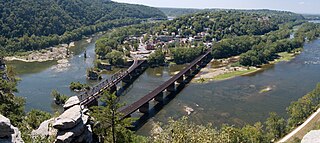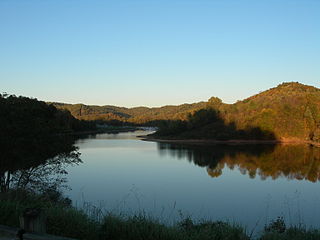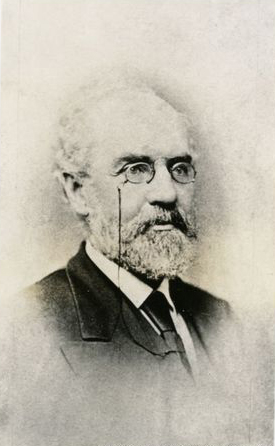
Thomas Jonathan "Stonewall" Jackson was a Confederate general and military officer who served during the American Civil War. He played a prominent role in nearly all military engagements in the Eastern theater of the war until his death. Military historians regard him as one of the most gifted tactical commanders in U.S. history.

Mount Jackson is a town in Shenandoah County, Virginia, United States. The population was 1,994 at the 2010 census.

Weston is a city in and the county seat of Lewis County, West Virginia, United States. The population was 3,943 at the 2020 census. It is home to the Museum of American Glass in West Virginia and the Trans-Allegheny Lunatic Asylum.

The Battle of Front Royal, also known as Guard Hill or Cedarville, was fought on May 23, 1862, during the American Civil War, as part of Jackson's Valley campaign. Confederate forces commanded by Major General Thomas J. "Stonewall" Jackson were trying to keep Union forces engaged in the Shenandoah Valley to prevent them from joining the Peninsula campaign. After defeating Major General John C. Frémont's force in the Battle of McDowell, Jackson turned against the forces of Major General Nathaniel Banks.
The Battle of Port Republic was fought on June 9, 1862, in Rockingham County, Virginia, as part of Confederate Army Maj. Gen. Thomas J. "Stonewall" Jackson's campaign through the Shenandoah Valley during the American Civil War. Port Republic was a fierce contest between two equally determined foes and was the most costly battle fought by Jackson's Army of the Valley during its campaign. Together, the battles of Cross Keys and Port Republic were the decisive victories in Jackson's Valley Campaign, forcing the Union armies to retreat and leaving Jackson free to reinforce Gen. Robert E. Lee for the Seven Days Battles outside Richmond, Virginia.

Cummins Edward Jackson was a paternal half-uncle of Confederate General Thomas Jonathan "Stonewall" Jackson (1824–1863) and a half-brother of David Edward Jackson. He owned and operated a grist mill at Jackson's Mill, Virginia.

Harpers Ferry National Historical Park, originally Harpers Ferry National Monument, is located at the confluence of the Potomac and Shenandoah rivers in and around Harpers Ferry, West Virginia. The park includes the historic center of Harpers Ferry, notable as a key 19th-century industrial area and as the scene of John Brown's failed abolitionist uprising. It contains the most visited historic site in the state of West Virginia, John Brown's Fort.

The West Fork River is a principal tributary of the Monongahela River, 103-mile (166 km) long, in north-central West Virginia, United States. Via the Monongahela and Ohio Rivers, it is part of the watershed of the Mississippi River, draining an area of 881 square miles (2,284 km²) on the unglaciated portion of the Allegheny Plateau.

Johnson Newlon Camden was a prominent oilman, industrialist, banker, railroad tycoon, and politician who was estimated to be worth $25 million at the time of his unexpected death. Although both of his attempts to become governor of the new state of West Virginia failed, he did become United States Senator, representing West Virginia on two occasions.

Stonewall Jackson Lake is an 2,630-acre (10.6 km2) impoundment on the West Fork River in Lewis County, West Virginia. The lake is a flood control project of the Pittsburgh District of the United States Army Corps of Engineers and named for Thomas "Stonewall" Jackson, a native of Lewis County. Stonewall Resort is located along the lake's shore. Facilities provided by the Corps of Engineers included a visitors center with public restrooms, a hiking trail, and fishing access.
Roanoke is an unincorporated community in southern Lewis County, West Virginia, United States. Most of the original town is located under 60 feet (18 m) of Stonewall Jackson Lake's water. A display at the Stonewall Resort State Park's lodge tells the story of the flood-plagued town that was purchased in the 1980s by the United States Army Corps of Engineers. The flood control dam at Stonewall Jackson Lake went into service in 1988. According to the U.S. Geological Survey, Roanoke has also been known as "Bush Mills", "Bushs Mills", "Roanville", and "Roanville Station".

Alexander Robinson Boteler was a nineteenth-century planter turned businessman, as well as artist, writer, lawyer, Confederate officer, philanthropist and politician from Shepherdstown in what was initially Virginia and became West Virginia in the American Civil War.

Orlando is an unincorporated community located in Braxton and Lewis counties, West Virginia, United States. It is located on Oil Creek, a tributary of the Little Kanawha River.

Joseph Andrew Jackson Lightburn was a West Virginia farmer, soldier and Baptist Minister, most famous for his service as a Union general during the American Civil War.
The Mountain Parkway Byway and Mountain Parkway Backway are two routes in northern Webster County, West Virginia. The Byway is a state-designated scenic byway which follows West Virginia Route 20 for 9.8 miles (15.8 km), traversing the headwaters of several mountain streams including the Right Fork Little Kanawha River, Jerry Run, and the Left and Laurel Forks of Holly River. The Backway explores backroads in the same area, is 32 miles (51 km) long, and follows stretches of the Right Fork Little Kanawha River and Left Fork Holly River for portions of its route.

Power Plant and Dam No. 5, also known as Honeywood Dam, comprises a dam on the Potomac River, originally built for the Chesapeake and Ohio Canal, and a power plant built to take advantage of the river's flow to generate hydroelectric power. The dam is included in Chesapeake and Ohio Canal National Historical Park.

Jackson's Mill State 4-H Camp Historic District, also known as West Virginia University Jackson's Mill, is a historic 4-H camp and national historic district near Weston, Lewis County, West Virginia. The district includes 23 contributing buildings, 4 contributing sites, 4 contributing structures, and 2 contributing objects. The camp was established in 1921 as the first statewide 4-H camp in the United States. The district includes buildings related to the site's inception as a homestead and agricultural area as well as its current manifestation as a youth camp facility and conference center.

Thomas Jonathan Jackson is a historic bronze equestrian statue of Confederate general Stonewall Jackson which was formerly located at Courthouse Historic District of Charlottesville, Virginia and installed in 1921. The statue was sculpted by Charles Keck and was the third of four works commissioned from members of the National Sculpture Society by philanthropist Paul Goodloe McIntire. It was the second of three statues McIntire donated to the city of Charlottesville, which he did over a period of five years from 1919 to 1924. The statue was listed on the National Register of Historic Places in 1997.

Charles James Faulkner was a politician, planter, and lawyer from Berkeley County, Virginia who served in both houses of the Virginia General Assembly and as a U.S. Congressman.


















